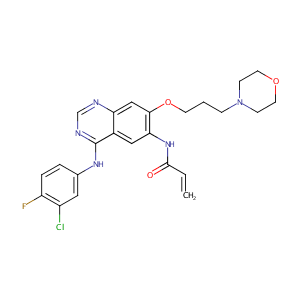Drug Information
| Drug General Information | Top | |||
|---|---|---|---|---|
| Drug ID |
D0YB3W
|
|||
| Former ID |
DCL000086
|
|||
| Drug Name |
CI-1033
|
|||
| Synonyms |
Canertinib; Canertinib HCl; Canertinib dihydrochloride; Canertinib dihydrochloride [USAN]; CI1033; PD 183805; Canertinib dihydrochloride (USAN); PD-0183805; PD-183805; Canertinib, PD-183805, CI1033, PD183805; N-[4-(3-Chloro-4-fluorophenylamino)-7-(3-morpholin-4-ylpropoxy)quinazolin-6-yl]acrylamide dihydrochloride; N-[4-[(3-Chloro-4-fluorophenyl)amino]-7-[3-(4-morpholinyl)propoxy]-6-quinazolinyl]-2-propenamide dihydrochloride; N-[4-(3-chloro-4-fluoroanilino)-7-(3-morpholin-4-ylpropoxy)quinazolin-6-yl]prop-2-enamide; N-[4-(3-chloro-4-fluoroanilino)-7-(3-morpholin-4-ylpropoxy)quinazolin-6-yl]prop-2-enamide dihydrochloride; N-(4-(3-chloro-4-fluorophenyl)amino)-7-(3-morpholin-4-yl)propoxy)quinazolin-6-yl)prop-2-enamide dihydrochloride; N-{4-[(3-chloro-4-fluorophenyl)amino]-7-[3-(morpholin-4-yl)propoxy]quinazolin-6-yl}prop-2-enamide; N-(4-((3-Chloro-4-fluorophenyl)amino)-7-(3-(morpholin-4-yl)propoxy)quinazolin-6-yl)prop-2-enamide; 2-Propenamide, N-(4-((3-chloro-4-fluorophenyl) amino)-7-(3-(4-morpholinyl) propoxy)-6-quinazolinyl)-, dihydrochloride; 2-Propenamide, N-(4-((3-chloro-4-fluorophenyl)amino)-7-(3-(4-morpholinyl)propoxy)-6-quinazolinyl)-, dihydrochloride
Click to Show/Hide
|
|||
| Drug Type |
Small molecular drug
|
|||
| Indication | Lymphoma [ICD-11: 2A80-2A86; ICD-9: 202.8, 208.9] | Phase 2 | [1], [2] | |
| Therapeutic Class |
Anticancer Agents
|
|||
| Company |
Pfizer
|
|||
| Structure |
 |
Download2D MOL |
||
| Formula |
C24H25ClFN5O3
|
|||
| Canonical SMILES |
C=CC(=O)NC1=C(C=C2C(=C1)C(=NC=N2)NC3=CC(=C(C=C3)F)Cl)OCCCN4CCOCC4
|
|||
| InChI |
1S/C24H25ClFN5O3/c1-2-23(32)30-21-13-17-20(14-22(21)34-9-3-6-31-7-10-33-11-8-31)27-15-28-24(17)29-16-4-5-19(26)18(25)12-16/h2,4-5,12-15H,1,3,6-11H2,(H,30,32)(H,27,28,29)
|
|||
| InChIKey |
OMZCMEYTWSXEPZ-UHFFFAOYSA-N
|
|||
| CAS Number |
CAS 267243-28-7
|
|||
| PubChem Compound ID | ||||
| PubChem Substance ID |
8034429, 10252913, 14883693, 46232231, 50100094, 50917991, 90342405, 99299163, 99432370, 103202250, 109693018, 111978347, 113435040, 123121573, 124756938, 124894124, 125163745, 125346553, 126645791, 126671639, 126731255, 127318548, 127318549, 127318550, 127318551, 127318552, 127318553, 128832430, 131465108, 134964336, 135187325, 135685374, 135685375, 135685393, 135727440, 136368009, 137059481, 137237688, 141965894, 143497675, 144115783, 144115784, 144115827, 144206912, 152234940, 152258193, 152344143, 160647029, 162011526, 162037387
|
|||
| ChEBI ID |
CHEBI:61399
|
|||
| References | Top | |||
|---|---|---|---|---|
| REF 1 | URL: http://www.guidetopharmacology.org Nucleic Acids Res. 2015 Oct 12. pii: gkv1037. The IUPHAR/BPS Guide to PHARMACOLOGY in 2016: towards curated quantitative interactions between 1300 protein targets and 6000 ligands. (Ligand id: 5675). | |||
| REF 2 | Tyrosine kinase inhibitors. 17. Irreversible inhibitors of the epidermal growth factor receptor: 4-(phenylamino)quinazoline- and 4-(phenylamino)pyrido[3,2-d]pyrimidine-6-acrylamides bearing additional solubilizing functions. J Med Chem. 2000 Apr 6;43(7):1380-97. | |||
| REF 3 | A comparison of physicochemical property profiles of marketed oral drugs and orally bioavailable anti-cancer protein kinase inhibitors in clinical development. Curr Top Med Chem. 2007;7(14):1408-22. | |||
| REF 4 | A phase I clinical and pharmacokinetic study of oral CI-1033 in combination with docetaxel in patients with advanced solid tumors. Clin Cancer Res. 2006 Jul 15;12(14 Pt 1):4274-82. | |||
If You Find Any Error in Data or Bug in Web Service, Please Kindly Report It to Dr. Zhou and Dr. Zhang.

